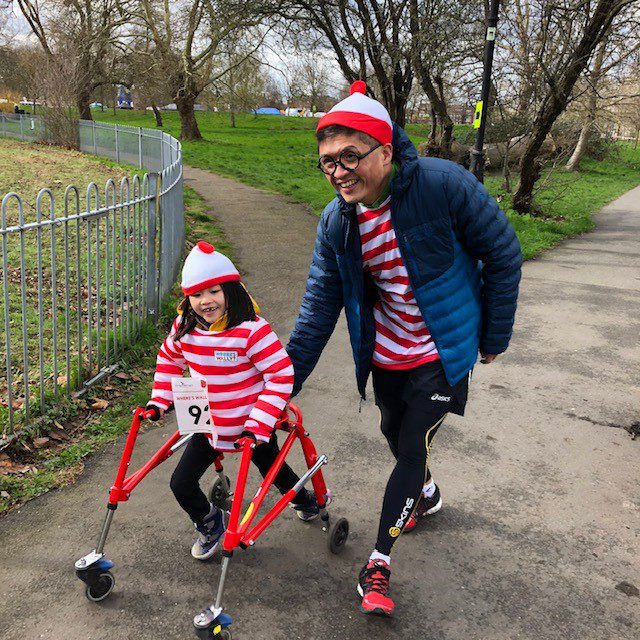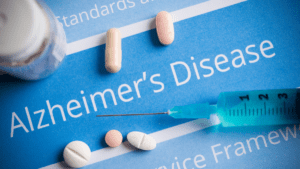
(SOURCE: SynaptixBio)
A Mother’s Journey, a Biotech for Her Daughter
By Mark Terry
March 7, 2023
Michelle Teng, Ph.D., says that her eldest daughter, Sofia, “had a very normal childhood.” It was only when Sofia turned two when she wasn’t walking independently that Michelle and her husband, Alan Tang, realized something was wrong. “It took ages for us to press for genetic testing and all the other tests needed to diagnose Sofia with H-ABC at age three-and-a-half.”
Michelle has since co-founded a biotech company in the UK, SynaptixBio, and a charity, the H-ABC Foundation. And if all goes well, the company’s therapeutic to treat H-ABC will enter the clinic at Children’s Hospital of Philadelphia (CHOP) and elsewhere next year.
H-ABC stands for “Hypomyelination with atrophy of the basal ganglia and cerebellum.” Caused by mutations in the TUBB4A gene, it is part of a larger group called TUBB4A-related leukoencephalopathy. TUBB4A codes for a specialized structural protein called tubulin, which form to build microtubules that provide structure to cells.


(SOURCE: SynaptixBio)
Individuals with TUBB4A-related leukoencephalopathy and H-ABC often have motor skills problems, which can lead to problems with walking, sitting, using hands, as well as speech and swallowing.
Teng says, “When the diagnosis came out, it was literally a report that said TUBB4a leukodystrophy. There was no further description. If you Google it, it’s a terrifying disease. Most children die within a year, and they suffer extreme pain, with all sorts of complications.”
Luckily for Teng, she had the scientific background to dig deeper. “I was saved by the science,” she says, “because I decided to rationally do some research on the kinds of leukodystrophies that had been described to date, and that was back in 2014.”
She found a recent paper that described H-ABC under the umbrella of Type 6 leukodystrophies. “After further investigation, I realized that was what Sophia had, believe it or not. None of the clinicians, the neurologist or the pediatricians in the UK could identify the condition.” She printed out the paper and took it with Sophia to a medical appointment with the pediatrician and after reading it, he agreed with the diagnosis.
“Why does a parent need to go through the anguish, pain, confusion and denial to get to the answer? And my story is not an isolated case. I know plenty of other parents have been through a similar kind of turmoil and I count myself fortunate in that I understood the papers and understood the research,” Teng says.
She adds, “Being able to grasp what’s happening to your daughter can be terrifying, but also redeeming because you feel you’re in more control over what you can do to support her. Doctors might say there’s nothing you can do. But I think there are enough parents out there who do not accept that narrative anymore. They’re going to either find a treatment, seek research groups and biotech companies that are working on the condition and galvanize them to work on a condition.”
Or in her case, co-found a biotech company and foundation to drive treatments, raise awareness, and raise money to help fund research. SynaptixBio was founded in 2021 with Bent Jakobsen and Dan Williams. Teng acts as Chief Scientific Officer.
SynaptixBio’s approach is based on the science that came out of the laboratory of Adeline Vanderver, M.D. at Children’s Hospital of Philadelphia. Vanderver and her team identified the causative mutation for H-ABC in 2015 and then discovered potential compounds to control the toxic mutation.
In 2022, SynaptixBio inked a licensing agreement with CHOP to develop the compound and to advance the research into clinical trials. The experimental compounds are antisense oligonucleotides (ASOs). ASOs have been developed to treat Duchenne muscular dystrophy (DMD) and spinal muscular atrophy (SMA).
ASOs are short, synthetic, single-stranded oligodeoxynucleotides able to alter RNA as well as decrease, modify and potentially restore protein expression.
Teng says the entire process took many years after Sofia was diagnosed. “I went through this internal wilderness about what to do about it. She was really young then and it wasn’t that severe. H-ABC is progressive, but she was still very much living like a normal child. She went to a normal school. There were development delays, like speech delays, and she can’t write independently, her scribbles are all over the place, but I wanted her to have friends that were healthy and happy and normal. I wanted her to have that childhood while she could when she could.”
During the COVID-19 pandemic, Teng says things took a “more sinister turn,” when medical support and educational support were no longer available. “We had to take matters into our own hands and either create that support structure around her ourselves or, we eventually moved her onto a special school that has the right system and technology to support her educational needs. But it took a while to get there.”
Teng is also the co-founder and CEO of Etcembly, which she calls “her escape, to be a scientist and do something I truly love and enjoy that is completely unrelated to Sophia and H-ABC.” Etcembly is a machine learning company using generative Artificial Intelligence to develop T-Cell Receptor (TCR) immunotherapies.
Meanwhile, progress is being made to move SynaptixBio’s experimental compound for H-ABC into Phase I clinical trials by the end of 2024. Teng notes that the disease is so rare, a “decentralized model is the most sensible approach…. But what’s really encouraging is we do have a patient registry and many parents who have come forward to say they’re interested in enrolling their children in a trial.”
Now Sofia is 12 years old. Due to a teacher’s strike in the UK, she wasn’t in school when BioBuzz had the chance to talk, so Teng took her swimming and then dropped her off at Sofia’s grandmother’s house so she could get work done.
Teng’s advice to parents in a similar situation is, “Don’t accept what the clinicians tell you. Go and find out for yourself. Go find the treatment! Go! Don’t despair and accept the status quo. The whole point of my speaking to the media is to empower other parents, to feel like they can change the genetic destiny of their own kids. It’s not just an end game because they have a mutation that they were born with.”
- About the Author
- Latest Posts
Mark Terry is a freelance writer, editor, novelist and ghostwriter. He holds a degree in microbiology & public health and spent 18 years in infectious disease research and clinical and research genetics prior to his transition to a writing career. His areas of expertise include biotechnology, pharma, clinical diagnostics, and medical practice management. He has written literally thousands of articles, as well as market research reports, white papers, more than 20 books, and many other written materials. He currently lives in Michigan with his family.






